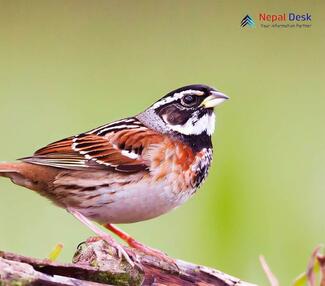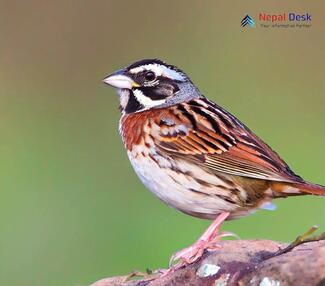The picturesque scenery of Nepal is home to a captivating bird species residing in its lush forests and mesmerizing observers with its melodic tunes: the Rustic Bunting (Emberiza rustica). This small, hard-to-find bird brings joy to those who adore birdwatching and the wonders of nature. In this article, we will take a closer look at the Rustic Bunting, examining its appearance, behavior, and presence in Nepal.
A Detailed Examination of the Rustic Bunting
The Rustic Bunting is a perching bird that belongs to the Emberizidae family. The compact body measures around 15-16 cm in length and weighs about 20-25 grams. When it comes to coloration, male Rustic Buntings features striking black and white streaks on their heads during the mating season, while females exhibit more subdued brown and beige shades.
One notable aspect of this bird species is its understated yet beautiful feathers. Their backs are generally covered in rich chestnut-brown, adorned with darker streaks. Meanwhile, the lower body displays a soft cream or pale gray color with brown stripes adorning the sides. Dark-edged feathers with white tips on their wings create delicate wing bars.
Rustic Buntings in Nepal: Presence and Preferred Habitats
Though these enchanting birds mainly breed further north in places like Scandinavia and Siberia, they migrate southwards to countries including China, India, and Japan, among others. Bird lovers in Nepal can spot them between October and March when they spend their winters there.
Rustic Buntings appreciate wooded areas such as mixed evergreen-deciduous forests and shrublands located at the base or along mountain slopes in Nepal. They prefer living close to water sources like streams or marshes and can often be observed searching for food near the ground, feeding on insects, seeds, and plant matter.
Status of Conservation and Significance
The Rustic Bunting is classified as Near Threatened by the International Union for Conservation of Nature (IUCN). Deforestation and human encroachment on their habitats significantly threaten their populations. Their use of agricultural lands during migration or wintering leaves them exposed to the dangers of pesticide contamination.
Playing a crucial role in their ecosystem, Rustic Buntings help control pest populations by consuming a variety of insects. Their presence also enhances Nepal's rich biodiversity, drawing birdwatchers and nature enthusiasts while boosting ecotourism.
To Summarize
The Rustic Bunting adds charm to Nepal's breathtaking landscape with its fascinating world. Observing this elusive bird in its natural surroundings is undoubtedly an exhilarating experience for visitors passionate about birdwatching. As we strive to understand and protect these delightful buntings, let us also acknowledge the ecological value they contribute to Nepal's incredible landscapes during their yearly visits.


